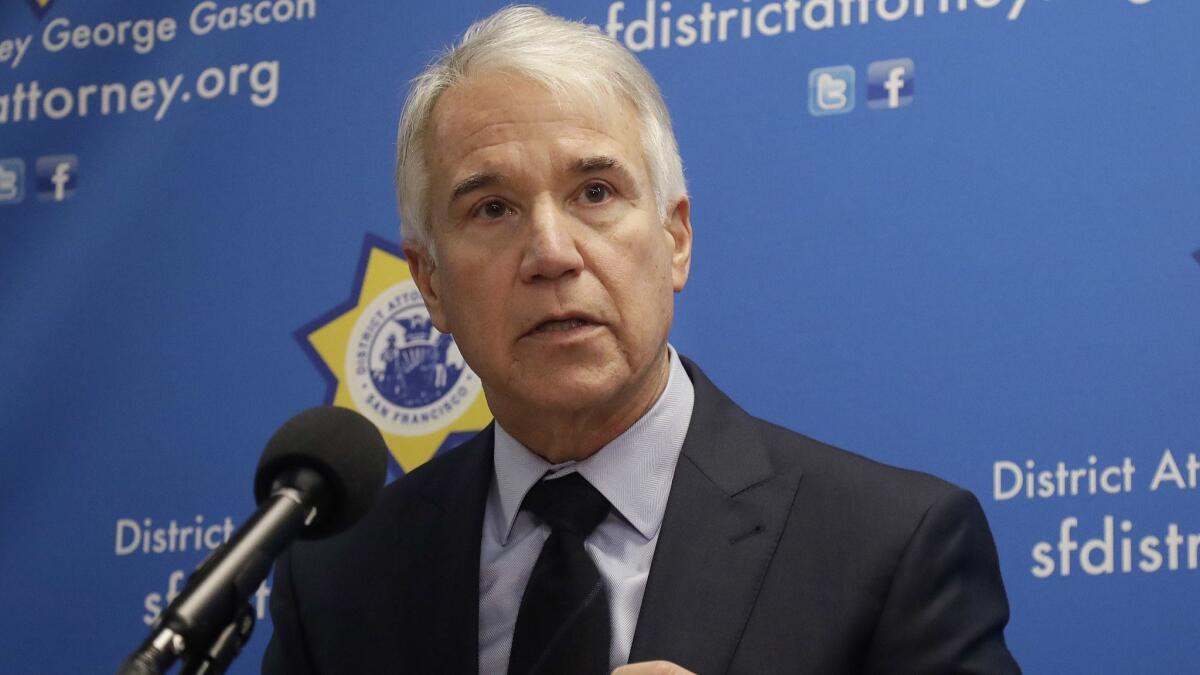Editorial: Tighten the blindfold on justice? Or remove it? The answer isn’t as easy as it seems

San Francisco Dist. Atty. George Gascon’s plan to remove any considerations of race from his prosecutors’ initial decisions about what charges to file in criminal cases reinvigorates an old debate: Is justice best served when it is all-seeing and all-knowing? Or when it is blind?
Gascon last week announced his plans to use a tool, developed by the Stanford Computational Policy Lab, to sweep names, crime locations and race from the police reports that prosecutors review before deciding whether to bring charges.
In a criminal justice system beset by racial bias, the thinking goes, prosecutors may inadvertently be swayed by a suspect’s race. They might be prone to see a shoplifting report filed against a white suspect as a sign of overzealous policing, but a similar report against a black suspect as an indication of a dangerous crime wave. Or vice versa. If racial data is deleted from the report — and if prosecutors are unable to glean that information from the suspect’s name, hair or eye color, or from the neighborhood where the crime is alleged to have occurred — couldn’t the justice system become more even-handed?
It is an intriguing idea, and worth testing.
It’s also important to keep in mind the many earlier efforts to ensure impartiality, and their sometimes unintended consequences.
Well-meaning (or perhaps not-so-well-meaning) even-handedness does its perverse work at even the most basic level of the criminal justice system.
In the 1970s, in an effort to rationalize and de-individualize justice, California adopted a policy known as determinate sentencing. No longer would there be punishments like three to 10 years in prison, with the ultimate term supposedly tied to the inmate’s behavior. That gave too much power to parole boards and prison officials, whose racial biases might affect when they let out any particular inmate.
With determinate sentencing, there would be a set and unvariable term imposed for each crime, regardless of the convict’s race, personal background or narrative.
But this supposedly more even-handed system of justice, soon adopted by other states, increased prison populations and made them more disproportionately nonwhite. That may be because discretion moved from parole boards and judges to prosecutors, who could in effect select sentences by selecting which crimes to charge and which to drop through plea-bargaining.
Well-meaning (or perhaps not-so-well-meaning) even-handedness does its perverse work at even the most basic level of the criminal justice system. For example, what could be more just, more fair, than imposing the same fine on every person who parks in a no-parking zone? And if a handful of drivers all get multiple tickets for their parking offenses, and then fail to pay them, what could be more even-handed than towing and impounding their cars until they pay the overdue fines, the tow and storage fees and the accumulated interest?
And if one of those drivers couldn’t afford to pay the tickets, fines and fees, and she’s now going to lose her low-paying job because she can’t get to work while her car is impounded (and maybe even has to spend a week in jail) — why should blindfolded justice care? On paper, the same laws, the same punishments and the same justice are being applied to everyone equally.
But such laws, blindly enforced, criminalize poverty. And because poverty disproportionately afflicts nonwhites, and especially African Americans, color-blind justice can be wielded as a tool to criminalize race.
Enter the Fray: First takes on the news of the minute »
Individualized justice is likewise imperfect, and can undermine faith in a system that is supposed to hold wrong-doers accountable. No person should be absolved of responsibility for their crimes because of race or social status. Consider the righteous outrage over the lenient sentences for the Stanford rapist or the Texas “affluenza” drunk driver.
In recent years, algorithms and new technologies have promised to remove human bias from many aspects of the justice system, including bail. But critics say these tools often simply amplify preexisting racial biases in the system.
Gascon’s “blind-charging” program eliminates racial references only in the initial phase of prosecutorial decision-making. Ultimately, the prosecutor sees everything, including the suspect’s race, before a final charging decision is made. If a prosecutor comes to a different decision once all the information is available, that will be recorded and the prosecutor will be asked why his or her decision changed. Answering that question could produce the most useful data.
The San Francisco system will properly include elements of both blind and wide-eyed justice. Both are likely needed throughout the criminal justice system. But how much of each, and at what point in the process? Those are questions the system’s leaders and front-line officers must keep asking — whether or not they ever land on a single permanent answer.
Follow the Opinion section on Twitter @latimesopinion and Facebook
More to Read
A cure for the common opinion
Get thought-provoking perspectives with our weekly newsletter.
You may occasionally receive promotional content from the Los Angeles Times.






